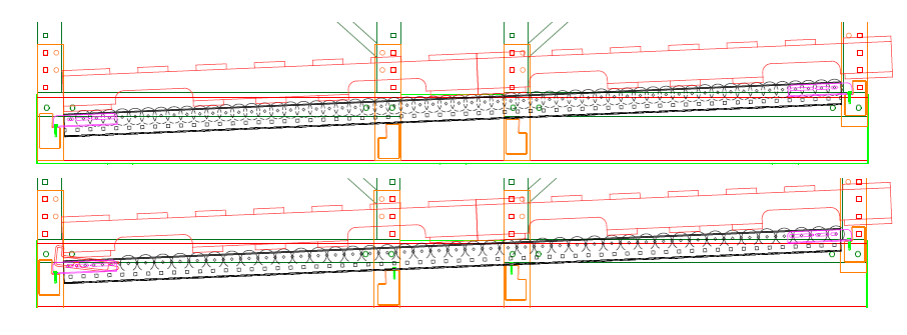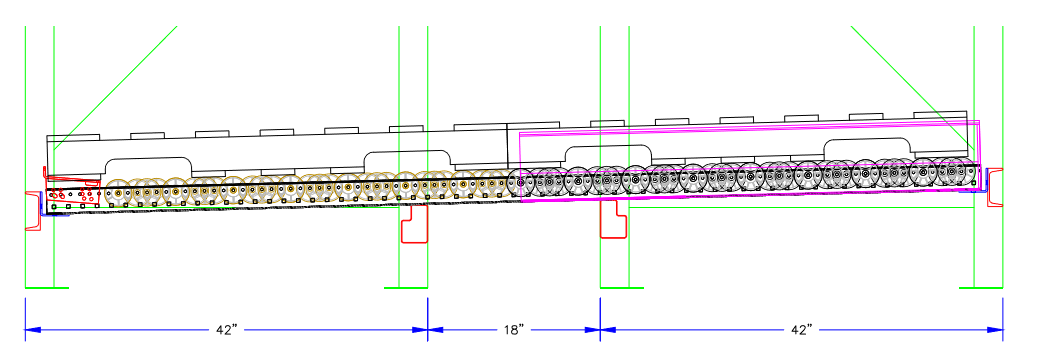Properly Planning Pallet Flow for the Pick Module
SOLUTIONS
FOR THE TOUGHEST APPLICATIONS
"*" indicates required fields
Thanks for dropping in to the Mallard “all things gravity flow” blog series. Consider this a public service announcement-type of topic that will hopefully save customers from an expensive warehousing design mistake… let’s talk about properly designing pallet flow rack for a pick module.
Pallet flow is an excellent choice for pick modules. It is an efficient, time-saving tool useful for case picking order fulfillment as well as for reserve storage of fast-moving SKUs, but proper lane depth is particularly important to ensure a safe and optimized pallet flow lane.
Design Scenarios – What NOT to Do:
It may seem that 96” double-deep, roll-formed rack structure would be sufficient to handle two-deep pallet flow, but let’s take a closer look. Note in Figure 1 (below) that the front pallet hangs out into the aisle by several inches. The pallet is stopped and held into the lane with a ramp stop, but the fact that the ramp stop and the pallet both overhang into the aisle is a safety hazard for personnel, equipment, inventory and the rack structure.

Figure 1: NOT RECOMMENDED – Pallet Hangs Out of Frame on Pick Aisle
In Figure 2 (below), the rear pallet extends past the pallet flow lane at the charge (or load side) of the rack. This pallet is likely to get caught on the edge of the roller or wheeled tracks causing a system hang-up. So, let’s see what can be done to optimize this system…

Figure 2: NOT RECOMMENDED – Pallet Hangs Out of Frame on Load Side
Design Scenarios – What TO Do:
The recommended length for a standard 2-deep pallet flow lane is 102” out to out which increases the lane depth of the previous example by 6”. This design uses two 42” deep standard selective rack uprights with 18” of space between the racks. The extra space expands the pallet flow lane enough to ensure that the pallets remain secured within the footprint of the rack, thus eliminating the above outlined safety issues, while also providing unobstructed movement of the pallets down the lane. See the examples Figures 3 & 4 (below):
Roll-Formed Pallet Rack Mount

Figure 3: RECOMMENDED – 102″ 2-Deep Pallet Flow Lane – Top View

Figure 4: RECOMMENDED – 102″ 2-Deep Pallet Flow Lane – Side View
Structural Pallet Rack Mount
The same 102” design is recommended for structural rack with the exception of the beam mounting brackets as can be seen in Figure 5 (below). These mounting brackets are specifically designed for adherence to structural beams. Mallard has several designs of mounting brackets for roll-formed and structural beam configurations. You can learn more about our mounting bracket options here.

Figure 5: Pallet Flow for 2-Deep Structural Rack
Pick Module with Case-Pick Separator
Our last design option includes properly spacing the lane to include a case-pick pallet separator (CP 100). This lane is 108” deep comprised of two 54” deep pallet rack frames. The additional 6” inches (108” vs 102”) provide the needed space for the separator to isolate the front pallet from the rear pallet.
The function of a pallet separator is to remove dangerous back pressure from the front pallet. Back pressure is defined as the force exerted from the weight of the rear pallets onto the front or pick-face pallet. This pressure can be figured as 6% of the combined weight of the rear pallets. Now, in a two-deep system we concern ourselves with the weight of only one pallet in the rear. However, consider that this pallet could 500 lbs. which is considered lightweight in many warehousing operations. 6% of 500 is still an additional 30 lbs. of pressure that effectively doubles the weight of that pallet as it is removed… over and over again.
Removing that pressure is simple with the addition of a Mallard case-pick separator secured into the center pallet flow lane as can be seen in Figure 6 (below). Note that the design featured is again a structural rack.

Figure 6: Pallet Flow with Pallet Separator
Note the addition of indirect mount speed controllers mounted under the pallet flow rail. Direct mount or drop-in speed controllers can be used if the application requires additional control over the speed of pallet advancement within the lane.
We hope this was a helpful overview for designing pallet flow lanes for use in pick module configurations. If you have any additional questions or would like to talk about your specific design challenges, give us a call, we’d be happy to work with you to develop just the right solution.
